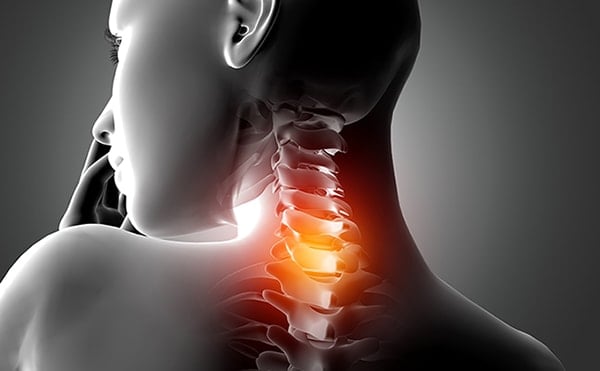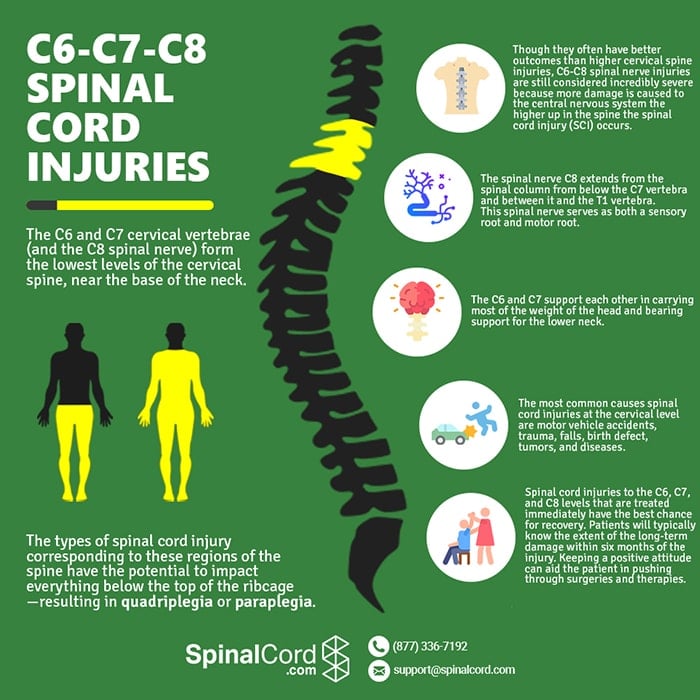C6, C7, & C8 Spinal Injuries
C7 spinal cord injury and other injuries to the lower cervical vertebrae/nerves can result in paralysis and other health complications.

C7 spinal cord injury and other injuries to the lower cervical vertebrae/nerves can result in paralysis and other health complications.
The C6 and C7 cervical vertebrae (and the C8 spinal nerve) form the lowest levels of the cervical spine and directly impact the arm and hand muscles. The locations of C6 and C7 vertebrae are both in the lowest levels of the cervical spine, near the base of the neck. The types of spinal cord injury corresponding to these regions of the spine have the potential to impact everything below the top of the ribcage—resulting in quadriplegia or paraplegia.
Though they often have better outcomes than higher cervical spine injuries, C6-C8 spinal nerve injuries are still considered incredibly severe because more damage is caused to the central nervous system the higher up in the spine the spinal cord injury (SCI) occurs. As is the case with any spinal cord injury, the damage is characterized as complete or incomplete depending on the severity.
The C6 spinal vertebra is part of the cervical spinal cord, located in the lowest region of the neck. The C6 nerve roots, which exit the spinal column between the C6 vertebra and the C7 vertebra, directly affects the control of the muscles in the forearms and wrists.

The C7 vertebra sits directly below the C6 spinal vertebra and is part of the lower levels of the cervical spine, near the base of the neck. It is the last vertebral level in the cervical spine column, which includes levels C1 - C7.
The C8 level corresponds to the region in which nerve roots exit the spine between the cervical spine's C7 vertebra and the thoracic spine's T1 vertebra. There is not a corresponding vertebra for C8. This nerve root is responsible for controlling muscles in the fingers and hands.
The C6 vertebra is also known as the sixth cervical vertebra. Following C6, the C7 vertebra is both referred to as the seventh cervical vertebrae and as the vertebra prominens. The vertebra prominens is the last bone in the cervical spinal column group. Since it is not a vertebrae, C8 is also labeled as the cervical spinal nerve 8.
The C6 vertebra is found in the inferior end of the neck, just above the thorax. A bony arch, known as the vertebral arch, wraps around the vertebra to provide attachment for muscles. The C7 is the most inferior vertebra, as well as the largest, in the neck area.
Between the C6 and C7 vertebrae are intervertebral disks, which are thin cushions of fibrocartilage for shock absorption and alignment. The C7 has similar anatomical characteristics to C6, except the C7 vertebra is superior to the first thoracic vertebra (T1) and earns the name vertebra prominens from it being visible and felt at the base of the neck.
Unlike C6 and C7, C8 is not a vertebrae, but is a cervical spinal nerve instead.

The spinal nerve C8 extends from the spinal column from below the C7 vertebra and between it and the T1 vertebra. This spinal nerve serves as both a sensory root and motor root. A C7 vertebrae pain or disc injury may indicate the C8 nerve is also at risk at being compressed or pinched.
These vertebrae protect the spinal cord, including the C8 nerve. Each vertebrae has a hollow, bony tunnel called the spinal canal which shields the spinal cord. The locations of C6 and C7 vertebrae allow them to support both the neck and the head. In addition to supporting the head, the cervical spinal column also allows for the neck and head’s range of motion.
The C6 also provides blood flow to the brain. The vertebra has openings to allow blood vessels to travel through it to the brain.
The C8 spinal nerve allows the brain to send motor controls for muscle movements. The C8 nerve helps control the hands, including finger flexion (handgrip) and the forearm.
The C6 and C7 support each other in carrying most of the weight of the head and bearing support for the lower neck. Although C8 does not have a vertebra, the nerve extends from the C7 vertebrae and exits out between C7 and T1 vertebrae from a small opening called the intervertebral foramen.
The most common causes of cervical spinal cord injuries are:
C6 injury symptoms may be experienced on one or both sides of the body, depending upon the extent of the damage. Survivors of injuries at this level may be able to drive a modified car with hand controls.
Patients with spinal cord tissue or nerve damage near the C6 vertebra often experience a false case of carpal tunnel syndrome. The patient will likely have numbness and / or tingling in the fingers, hands, and arms. Therapy, such as C6 spinal cord injury exercises, may address these issues.
The patient may also experience the following:
Having C7 vertebrae pain is an indicator of damage to this vertebrae. A survivor of a C7 SCI will likely have full neck movement but may sense tingling and numbness in the hands and fingers, as well as referred pain in the shoulder blade.
Symptoms of a C7 SCI include:
Types of spinal cord injury to this area have similar symptoms to those at the C6 and C7 levels. Depending upon the completeness, a C8 injury will lead to paralysis of the legs, trunk, and hands, with patients maintaining shoulder and arm movement.
Treatment for these types of spinal cord injury are aimed at retaining as much function as possible while regaining lost function. Several therapy options may be tried to aid in spinal cord damage recovery.
Mental therapy for a C8 injury and vertebrae damage is also a very important part of treating a spinal cord injury patient. The therapist can help the patient deal with the emotional side of recovery.
Spinal cord injuries to the C6, C7, and C8 levels that are treated immediately have the best chance for recovery. Patients will typically know the extent of the long-term damage within six months of the injury. Learning to deal with the limitations of the injury is a very important part of the recovery phase. Keeping a positive attitude can aid the patient in pushing through surgeries and therapies.
Spinal cord injuries are traumatic for patients and their families. They cause disruptive changes to every aspect of your life and there is a lot of new information to navigate and understand. Our experts have collected everything in one place to help you learn more about your injury, locate doctors and treatment centers, find financial support, and get assistance navigating your next move.
Sponsored by Tampa personal injury lawyers at Swope, Rodante P.A. a Florida law firm located at 1234 E 5th Ave, Tampa, FL 33605.
The information provided by SpinalCord.com is not a substitute for professional medical advice, diagnosis, or treatment, see Disclaimer Policy.